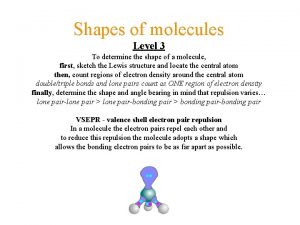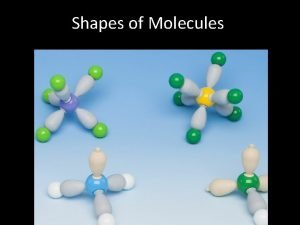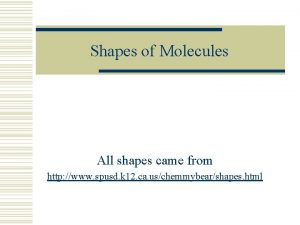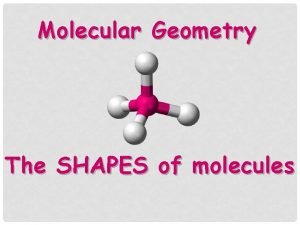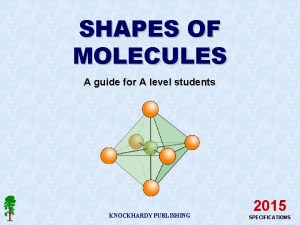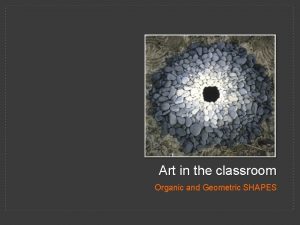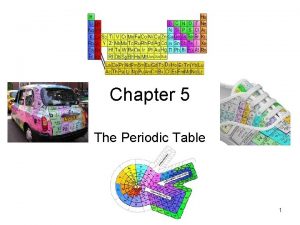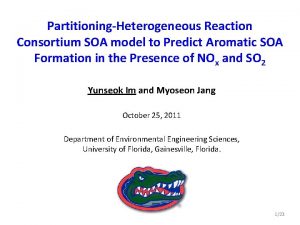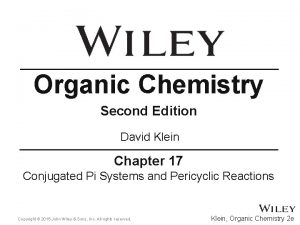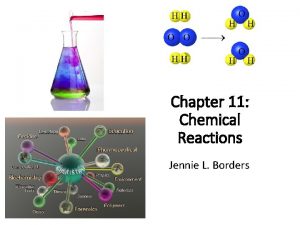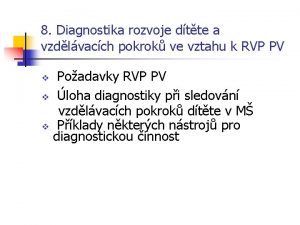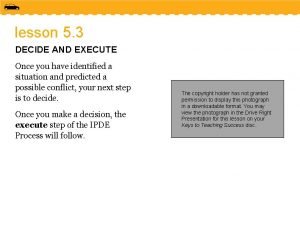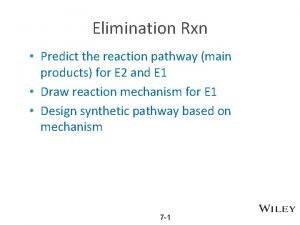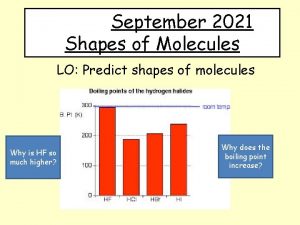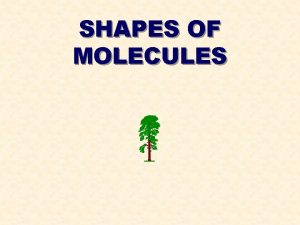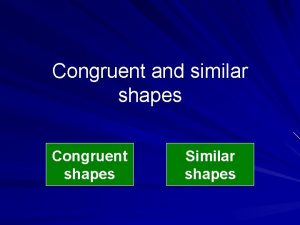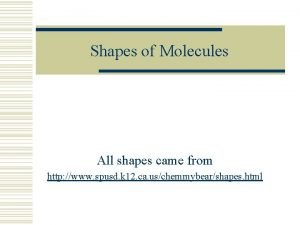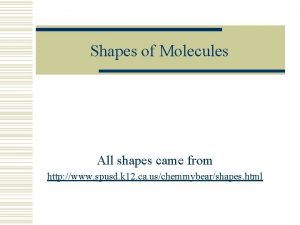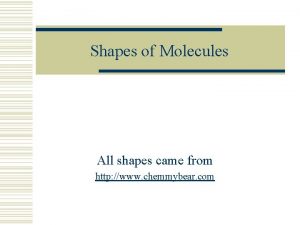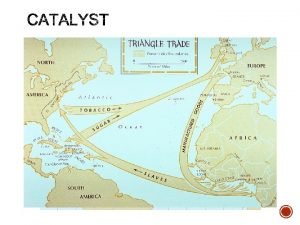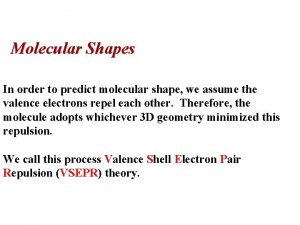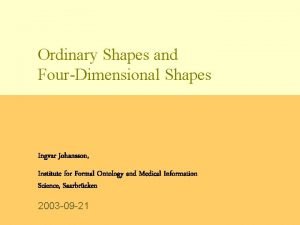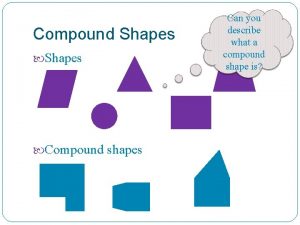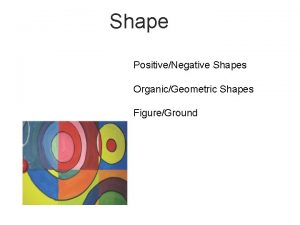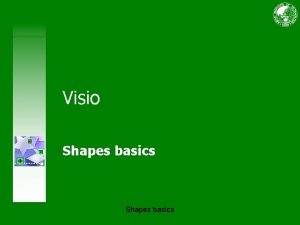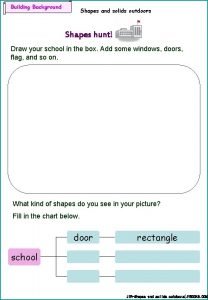Shapes of Molecules 4 2 7 Predict the


























- Slides: 26

Shapes of Molecules

• 4. 2. 7: Predict the shape and bond angles for species with four, three and two negative charge centres on the central atom using the valence shell pair repulsion theory (VESPR).

• Before you start it would be helpful to… • know the definition of a covalent bond • know what a lone pair is • know that like charges repel A lone pair is a pair of electrons in the valence shell of an atom, which are not used to form covalent bonds. We came across them when we did Lewis structures!

• Covalent molecules are not flat – even though that’s how we usually draw them. • They exist in 3 dimensions and have specific shapes. • We can see these shapes using computer simulations, or by making models using Molymod kits.


• During exams(!) we won’t have either of these methods available, so we have to use VSEPR theory to predict the shape of the molecule. • We then use certain conventions to draw the molecule.


VSEPR • This means “valence shell electron pair repulsion” • You can probably see why we just use the initials. . . • BUT it does tell us that the shape of a molecule is due to the number of electron pairs in the outer (valence!) shell.

• Its best to learn the principles behind this. • You can worry about all the fancy words later! • It is possible to consider the shape around any atom in a (covalently bonded) molecule • But at IB level they will usually only ask questions where its obvious which atom they want you to consider.


• The first step is to figure out how many areas of “high electron density” there around the atom we’re interested in. • This means IF IN DOUBT DRAW A LEWIS STRUCTURE! • Areas of high electron density could be a covalent bond, a double or triple bond or a lone pair of electrons. • Notice that double and triple bonds are only ONE area of high electron density.

2 areas of high electron density 4 areas of high electron density

• Because like charges repel, • Areas of high electron density try to get as far apart as possible. • Because valence shells usually have 8 electrons, • The commonest case is 4 areas of HED • This gives a tetrahedron


E. g. Methane BOND PAIRS 4 LONE PAIRS 0 This will be important in a few minutes! BOND ANGLE. . . SHAPE. . . 109. 5° TETRAHEDRAL

• The bond angle of 109. 5 degrees is fixed as a property of a tetrahedron. • Where a central molecule is surrounded by 4 bonding electron pairs, the bond angle is ALWAYS 109. 5 degrees. • However, sometimes one of the areas of HED will be a lone pair. • Lone pairs are closer to the central atom and repel the bonding electrons a bit more strongly.

Ammonia Bond pairs 3 Lone pairs 1 Bond angle Shape 107 degrees Trigonal pyramidal

• If there are 2 lone pairs of electrons, the bonds are forced even closer together.

Water Bond pairs 2 Lone pairs 2 Bond angle 104. 5 degrees Shape “bent” or “ vshaped”

• Its important to keep in mind that the shapes we have just discussed are all just variations on a tetrahedron. • Its just that lone pair electrons make part of the tetrahedron “invisible”! • If you know the science involved, you can work out the bond angles. • Don’t stress too much about learning the names of the shapes. • You will need to do it, but it shouldn’t be too hard.

• Exactly the same science is involved for shapes which aren’t based on a tetrahedron.

Carbon dioxide There are 2 areas of high electron density round the carbon The furthest apart that 2 areas of HED can get is 180 degrees Bond angle 180 degrees Shape Linear

BF 3 There are 3 areas of high electron density round the boron The furthest apart that 3 areas of HED can get is 120 degrees Bond angle 120 degrees Shape Trigonal planar

SO 2 There are 3 areas of high electron density round the sulfur The lone pair forces the bonding electrons slightly closer together Bond angle 117 degrees Shape Bent or v-shaped

• These are the only shapes that SL students need to know! • HL need a few more! • Notice that in some cases the actual bond angles given are only approximate! • The “real” angle changes depending on the environment.

 Organic molecules vs inorganic molecules
Organic molecules vs inorganic molecules Types of molecular shapes
Types of molecular shapes Shapes of molecules a level
Shapes of molecules a level Chemsheets shapes of molecules
Chemsheets shapes of molecules Structure types chemsheets
Structure types chemsheets Steric number
Steric number Cmp shorthand
Cmp shorthand Tetrahedral electron geometry
Tetrahedral electron geometry Shapes of molecules a level
Shapes of molecules a level Chemsheets a2 1024
Chemsheets a2 1024 Nh bond polarity
Nh bond polarity A level chemistry shapes of molecules
A level chemistry shapes of molecules Organic and geometric shapes
Organic and geometric shapes Predict whether cesium forms cs or cs2 ions
Predict whether cesium forms cs or cs2 ions 1pox1
1pox1 Teknik randomisasi adalah
Teknik randomisasi adalah Diels alder reaction
Diels alder reaction Predict the products of the following reactions.
Predict the products of the following reactions. Predict meaning of gratifying
Predict meaning of gratifying Nnn zkratka
Nnn zkratka Predict
Predict Predict the sources of water
Predict the sources of water When you apply the ipde process you may decide to
When you apply the ipde process you may decide to Example of active reading
Example of active reading Predict cyber crime
Predict cyber crime Predict the products of the elimination reaction.
Predict the products of the elimination reaction. What did manifest destiny predict?
What did manifest destiny predict?


